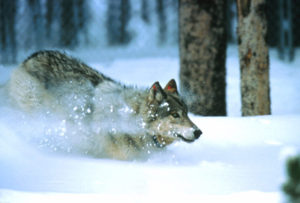Using Stories to Motivate: Teaching Tips
 By William Lowry, Ph.D., Professor of Political Science and Environmental Studies (By Courtesy), Washington University in St. Louis
By William Lowry, Ph.D., Professor of Political Science and Environmental Studies (By Courtesy), Washington University in St. Louis
People sometimes say that one key to teaching is to ask good questions. While I certainly agree with that, I would add that you also have to motivate students to want to know the answers to those questions. One of the best ways to do that is with a compelling story. The following is an example.
Let’s suppose the question is “how do people change policies when those changes are controversial?” Here’s a story that should motivate students to want to know the answer.
 The most spectacular thing I ever saw in a wilderness setting occurred one early May morning in the Lamar Valley in Yellowstone National Park. It had snowed the day before so the valley was beautiful, the snow drifts still showing on the mountains surrounding the grassy meadows. The valley was also full of animals, from pronghorn antelope to bison to coyotes. I was sitting on a hillside with about two dozen other people, watching a pack of wolves feeding on an elk they had killed the night before. Suddenly a grizzly bear mother and her two cubs, both in their second year and thus the equivalent of teenagers, wandered into the meadow and sniffed the air. Catching the scent of the dead elk, they started walking toward it. The wolves saw the bears coming and moved out to stop them from stealing their meal. For the next two hours, we watched a battle between five wolves and three bears. It was raw, brutal and also magnificent in a primordial way. And the fact was that I would not have been able to witness such a spectacle at any point in the sixty preceding years because wolves had been intentionally eliminated from Yellowstone. Then in the mid-1990s, advocates had successfully reintroduced the wolves I was watching below. Bringing wolves back into an area where they had not existed for decades is a very controversial policy change. So, how were proponents successful?
The most spectacular thing I ever saw in a wilderness setting occurred one early May morning in the Lamar Valley in Yellowstone National Park. It had snowed the day before so the valley was beautiful, the snow drifts still showing on the mountains surrounding the grassy meadows. The valley was also full of animals, from pronghorn antelope to bison to coyotes. I was sitting on a hillside with about two dozen other people, watching a pack of wolves feeding on an elk they had killed the night before. Suddenly a grizzly bear mother and her two cubs, both in their second year and thus the equivalent of teenagers, wandered into the meadow and sniffed the air. Catching the scent of the dead elk, they started walking toward it. The wolves saw the bears coming and moved out to stop them from stealing their meal. For the next two hours, we watched a battle between five wolves and three bears. It was raw, brutal and also magnificent in a primordial way. And the fact was that I would not have been able to witness such a spectacle at any point in the sixty preceding years because wolves had been intentionally eliminated from Yellowstone. Then in the mid-1990s, advocates had successfully reintroduced the wolves I was watching below. Bringing wolves back into an area where they had not existed for decades is a very controversial policy change. So, how were proponents successful?
 Here is a succinct version of the explanation. One of the most compelling lessons in political science is that if someone seeking a particular outcome is losing to opponents, they can succeed if they expand the sphere of conflict to bring in the audience on their side. This applies to everything from a one-on-one fight to a political election. In the case of the wolves, proponents of reintroduction expanded the sphere of conflict beyond the traditional battle between environmentalists and ranchers to successfully engage the broader American public. They did so with a range of arguments. The scientific argument was that reintroduction would restore balance to the ecosystem. Specifically, without natural predators such as wolves, the elk population had expanded to the point where it was problematic for vegetation, other creatures and even the elk themselves. The economic argument was that wolves would bring in tourists to the area. Yes, ranchers would suffer some losses from wolf kills, but any cost-benefit calculation for the overall economy of the area showed far greater benefits than costs. Finally, the esthetic argument for bringing back an animal that had existed in an area that was supposed to represent a more primitive and natural America was powerful. And it didn’t hurt that the movie “Dances with Wolves” won the award for Best Picture in 1990. Long story short, proponents changed public opinion from opposition to wolves to strong support for the reintroduction.
Here is a succinct version of the explanation. One of the most compelling lessons in political science is that if someone seeking a particular outcome is losing to opponents, they can succeed if they expand the sphere of conflict to bring in the audience on their side. This applies to everything from a one-on-one fight to a political election. In the case of the wolves, proponents of reintroduction expanded the sphere of conflict beyond the traditional battle between environmentalists and ranchers to successfully engage the broader American public. They did so with a range of arguments. The scientific argument was that reintroduction would restore balance to the ecosystem. Specifically, without natural predators such as wolves, the elk population had expanded to the point where it was problematic for vegetation, other creatures and even the elk themselves. The economic argument was that wolves would bring in tourists to the area. Yes, ranchers would suffer some losses from wolf kills, but any cost-benefit calculation for the overall economy of the area showed far greater benefits than costs. Finally, the esthetic argument for bringing back an animal that had existed in an area that was supposed to represent a more primitive and natural America was powerful. And it didn’t hurt that the movie “Dances with Wolves” won the award for Best Picture in 1990. Long story short, proponents changed public opinion from opposition to wolves to strong support for the reintroduction.
And, oh yeah, if you’re wondering who won the battle over the elk carcass, you’re not alone. Every time I tell this story, people want to know the outcome. And isn’t that the point? The audience is motivated. Anyway, the specific answer to that question is the following. If a grizzly bear is hungry, nothing short of death will stop it from getting food. They fought off the wolves and ate their fill.





